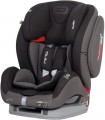Installation
—
Seat belt. Installation with the car seat belt. In weight groups 0, 0+ and 1, only the seat is secured in this way; the child's safety is ensured by the seat's own belts. In weight groups 2 and 3, the car belt is used to secure both the seat and the child.
—
Tor Tether. An additional harness to increase the security of fixation used in seats with Isofix and Latch systems (see below). One end of the harness is attached to the upper part of the backrest and the other end is attached to a special bracket installed in the floor of the car behind the seat or in the trunk. This reduces the likelihood of the seat being knocked over in a sudden braking or frontal impact and increases the overall safety of the small passenger.
—
Support leg. An additional attachment in the form of a support running from the bottom of the seat to the floor of the car. The purpose is similar to the Top Tether described above: it increases the safety of the seat and reduces the risk of the seat toppling when the car comes to a sudden stop. It is most often used with the Isofix system.
—
ISOFIX. The installation system for car seats in the weight category up to 18 kg is primarily found in cars from European manufacturers. The seat is secured with two locks in the rear lower part, with optional additional attachments at the top and/or b
...ottom. The design ensures foolproof installation, making it nearly impossible to install the seat incorrectly. Isofix requires the car to be equipped with suitable brackets, but even without them, these seats can usually be securely installed using the regular seat belt. However, this option may not be cost-effective, as seats with the Isofix system tend to be relatively expensive.
— LATCH. Installation system similar to Isofix. It is used mainly in American cars and, accordingly, in car seats of American manufacturers. The seat is attached at three points — two at the bottom of the seat and one at the top — so that the seat cannot be installed incorrectly. Like Isofix, seats with Latch also allow fixation with the normal car seat belt.Correct installation indicator
The presence in the design of the child restraint system of special
indicators of correct installation. They help ensure that the child car seat is installed correctly and follows all prescribed safety guidelines. Most often, such indicators are represented by special marks that change color or position when the car seat is installed correctly. Such indicators are placed on Isofix system locks, seat belts for fastening a child, etc. And some models for the youngest passengers have built-in levels or angle indicators that help set the seat in the correct position, facing the rear of the vehicle.
Additional side protection
The car seat has structural elements that further protect the child from side impacts. At least such elements include sidewalls for head protection made of impact-absorbing material such as polyurethane foam; torso protection may also be provided. If you are looking for a car seat with the maximum level of protection, you should choose from models with
additional side protection.
Country of origin
The country of origin of the brand under which the product is marketed. Often indicated by the nationality of the company or the location of its headquarters. At the same time, the actual production capacity of the brand often differs from the country of origin.
The quality of products is more influenced by the organization of processes and quality control at all production stages than by geography. Therefore, biases against brands from specific regions are generally unfounded. Consideration of a brand's country of origin becomes relevant only when the goal is to actively support or avoid manufacturers from a particular state.

